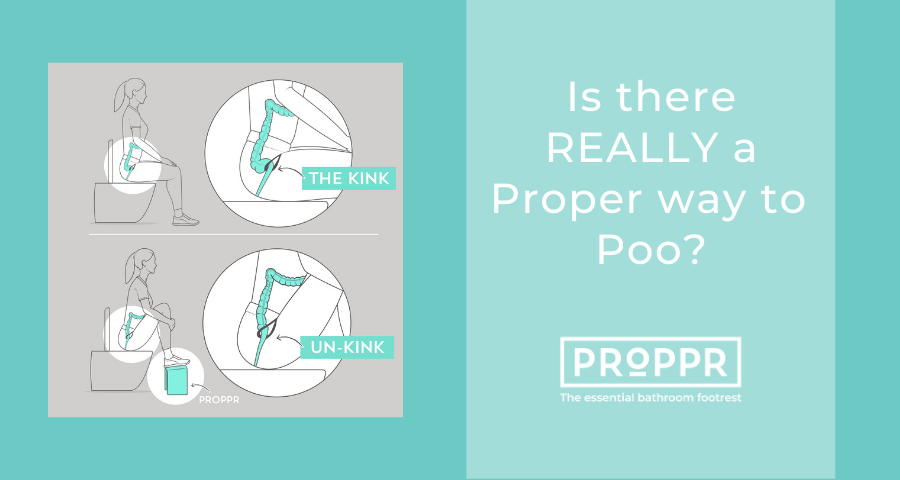Is there really a proper way to poo? Does it really make a difference to our gut health if we change our body alignment on the toilet? The simple answer is yes! We were meant to squat to poo.
We were designed to squat to poo; it’s true!
Have you ever gone camping? Or traveling through Asia?
For thousands of years we humans all squatted to go to the loo. It’s how our bodies were designed to release. Have you ever observed a toddler hiding under the dining table and squatting to do a poo in their nappy? Those toddlers could teach us (or re-teach us) a lesson. They are simply demonstrating our inbuilt and natural instinct that squatting down IS the proper way to poo! Squatting is and always has been the natural way to move our bowels. So why has this changed and why are we now sitting on our ‘thrones’?
A little toilet history
The first basic toilets are thought to date back to around 6,000 years ago. Many years later the Romans created toilet rooms where they would sit together and “shoot the shit”, catching up on the day’s events. This may be why to this day we use our bathrooms as a way to relax, escape and endlessly scroll through Instagram?!
The invention of the flush pedestal toilet came in 1592, and as you can imagine, it was something of a status symbol. It was reserved for the noble and royal; the only members of society able to afford such a luxury. A few centuries later, when the toilet was actually lifted off the ground due to advances in plumbing, we started to see its more widespread use. And… interestingly, more gut ailments in the Western World. Hmmm.
The most ill-suited fixture ever designed?
In his book The Culture of the Abdomen, published in 1924, Dr William Welles quoted leading medical authorities who were outspoken about the faulty design of the new seated toilet; and the resultant health consequences. In the book he wrote “It would have been better if the contraption had killed its inventor before he launched it under humanity’s buttocks!” And in the mid-1960’s, Cornell University professor Alexandra Kira, described the seated toilet as “the most ill-suited fixture ever designed.”
Also around the mid-20th century, a group of European doctors working in rural Africa were surprised to find very few bowel and digestive issues among the population. This trend and observation was similarly reflected in other parts of the developing world, in countries where squat toilets were still the go to. Countries located in areas like… you guessed it, Asia.
So, why is squatting so great?
All of us have a puborectalis muscle which we absolutely need as it kindly assists us in avoiding ‘pooping accidents’. But when we sit down to do our number 2’s on our pedestal toilets it puts our anal canal at a 90 degree angle. This angle causes the puborectalis muscle in the pelvic floor to choke our colon, which can in turn lead to straining and pushing when on the loo. This isn’t ideal for anyone; just ask Elvis.
But when we squat, or at least replicate the squat position, this 90 degree angle lessens to about 35 degrees. And our number 2’s can make a smoother escape. Now that’s the proper way to poo.
Anatomically speaking…
Here’s another way of explaining it. Our waste has to make it around our torso from the lower right side of our colon, the ascending colon, all the way around to the other side, our descending colon. Then it heads to the last exit point, the sigmoid colon, or the ‘exit ramp’ as it is sometimes called.
When the puborectalis muscle is engaged, this exit ramp is backed up like Sydney traffic on a Friday heading north for a long weekend. Nothing is moving! Once we replicate a squat by putting our feet up onto a bathroom foot stool like a PROPPR, then traffic starts moving and we can continue belting out our favourite road trip songs!
But don’t just take our word. A PROPPR friend sent us a link to this fabulous little video courtesy of the BBC and their ‘IDEAS’ page. It’s only a few minutes and we’re sure you’ll be entertained.
Why is this so important you might ask?
Well, the colon is the main organ for the storage and elimination of waste and toxins from our bodies. Going regularly and more completely reduces the build-up between each bowel movement and also the accumulation of toxins. With a more complete bowel movement we can help reduce the risk of many of the issues that affect us in modern western cultures. Issues such as bowel disease, constipation, haemorrhoids, bloating and many more can be reduced.
Eliminating completely and often helps maintain good colon health. And when our colons are clearer our bodies stand a better chance of absorbing all the nutrients from the food we eat, allowing us to enjoy more energy.


